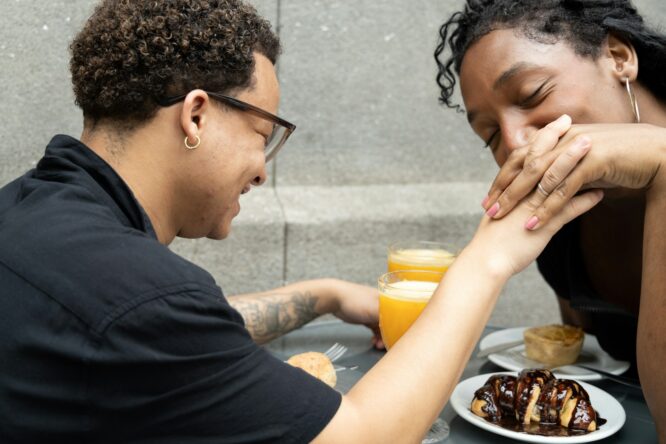Religion and technology might seem like they’d be natural enemies, but something fascinating is happening right now.

Instead of digital life killing off spiritual practices, tech is actually transforming how people connect with their faith in ways that would’ve been unimaginable even a decade ago. It’s not just down to livestreamed services during the pandemic—though that certainly accelerated things. This is about a fundamental change in how people experience, share, and live out their spiritual beliefs in an increasingly connected world. Some of these changes are pretty remarkable, others are a bit concerning, and all of them are reshaping what it means to be religious in the 21st century.
1. Prayer apps are becoming spiritual companions.

Millions of people now have prayer apps on their phones that send daily reminders, provide guided meditations, and even track spiritual habits like a fitness app tracks steps. Apps like Pray as You Go or Abide have become digital spiritual directors, offering personalised prayer experiences that adapt to your schedule and spiritual needs. It’s wild to think that your phone—the same device you use for doom-scrolling social media—can also serve as a gateway to deeper spiritual practice.
What’s really interesting is how these apps are making prayer more accessible to people who might feel intimidated by traditional religious settings. You can explore different prayer styles, learn about various spiritual traditions, and develop a consistent practice without having to navigate the social dynamics of a religious community. Of course, this also means you might miss out on the communal aspects of faith that many find essential. It’s convenience versus community, and different people are finding different balances.
2. Virtual reality is creating immersive pilgrimage experiences.

You can now take a virtual pilgrimage to Mecca, walk through the Vatican, or visit Buddhist temples in Tibet without leaving your living room. VR technology is making sacred spaces accessible to people who could never afford to travel there physically, whether due to money, health issues, or geographic limitations. Companies are creating detailed, interactive experiences that let you participate in religious rituals and ceremonies alongside people from around the world.
This democratisation of religious experiences is pretty revolutionary when you think about it. Historically, pilgrimage was something that required significant resources and often served as a marker of devotion precisely because it was difficult. Now, the barriers are much lower, which raises interesting questions about the spiritual value of ease versus struggle. Some argue that the physical and financial sacrifice was part of what made pilgrimage meaningful, while others see virtual access as a more inclusive way to share sacred experiences.
3. AI is providing personalised spiritual guidance.

Artificial intelligence is starting to serve as a sort of digital chaplain, offering personalised spiritual advice and guidance based on your specific questions and circumstances. These AI systems can draw from vast databases of religious texts, theological scholarship, and spiritual wisdom to provide responses that feel surprisingly thoughtful and relevant. Some people are finding genuine comfort and insight through conversations with AI spiritual advisors.
The weird part is that many folks report feeling less judged talking to an AI about their spiritual struggles than they would speaking to a human religious leader. There’s something about the anonymity and perceived objectivity that makes people more open to sharing their doubts, fears, and questions. Whether this is ultimately good or bad for spiritual development is still being debated—you get privacy and accessibility, but you also lose the human connection and wisdom that comes from speaking with someone who’s lived through similar struggles.
4. Social media is creating new forms of religious community.

Religious communities are forming on platforms that were never designed for spiritual purposes. Facebook groups, Instagram accounts, and TikTok creators are building massive followings around shared faith experiences. You’ve got pastors going viral on TikTok, rabbis hosting live Q&As on Instagram, and Buddhist monks sharing mindfulness tips through Twitter threads. These digital communities often feel more authentic and accessible than traditional religious institutions to younger generations.
What’s particularly interesting is how these online communities can be simultaneously more diverse and more fragmented than traditional congregations. You might connect with believers from completely different backgrounds and cultures, but you also risk ending up in echo chambers that reinforce only your existing beliefs. The algorithm-driven nature of social media means you’re more likely to see content that confirms what you already think, rather than being challenged by different perspectives within your faith tradition.
5. Cryptocurrency is funding religious projects.

Some religious communities are embracing cryptocurrency as a way to fund projects and accept donations. Churches are setting up Bitcoin wallets, religious charities are accepting crypto donations, and some faith-based organisations are even creating their own digital currencies. There’s something oddly fitting about using decentralised, trustless currency systems for institutions that are fundamentally about trust and community.
This move toward crypto is also opening up new questions about religious ethics and economics. Some see it as a way to reduce reliance on traditional banking systems and government oversight, while others worry about the environmental impact and speculative nature of many cryptocurrencies. It’s creating interesting theological discussions about money, value, and stewardship that religious communities are still working through.
6. Streaming services are competing for religious content.
 Source: Unsplash
Source: Unsplash Netflix, Amazon Prime, and other platforms are investing heavily in religious content, from biblical dramas to documentaries about different faith traditions. This isn’t just about entertainment—it’s reshaping how people learn about and engage with religious stories and ideas. Shows like “The Chosen” have built massive followings that extend far beyond traditional Christian audiences, and platforms are noticing that faith-based content performs really well with certain demographics.
The quality and production value of religious content has skyrocketed as streaming platforms compete for viewers. You’re getting biblical stories with Marvel-level special effects and theological documentaries that rival anything you’d see on the History Channel. This is making religious content more appealing to people who might never step foot in a church, but it’s also raising questions about how entertainment value might be changing the way people understand and relate to sacred stories.
7. Dating apps are sorting people by religious compatibility.

Faith-based dating apps like Christian Mingle, JSwipe, and Muzmatch are helping people find partners who share their religious values and practices. These platforms go way beyond just asking about your religion—they dig into specifics about practice level, denominational preferences, and religious goals. You can filter potential matches based on how often they attend services, their views on religious law, or their openness to interfaith relationships.
This level of religious filtering is creating interesting dynamics in how people approach both dating and faith. On one hand, it’s helping people find partners who truly understand and share their spiritual values. On the other hand, it might be creating more religious segregation in relationships and families. Some argue that interfaith relationships can be enriching and help people grow spiritually, while others believe shared faith is essential for long-term compatibility.
8. Blockchain is being used to verify religious credentials.

Some religious organisations are starting to use blockchain technology to issue and verify religious credentials, certifications, and ordinations. This creates a permanent, tamper-proof record of someone’s religious education and authority that can be verified anywhere in the world. It’s particularly useful for religions with complex hierarchical structures or for people who move frequently between different religious communities.
This technology is also being used to authenticate religious texts and artifacts, creating permanent records of provenance and preventing forgery. While this might seem like a niche application, it’s actually addressing some real problems around religious authority and authenticity that have plagued faith communities for centuries. The irony is that some of the most traditional religious institutions are embracing cutting-edge technology to preserve and verify their most ancient traditions.
9. Mental health apps are incorporating spiritual practices.

Mainstream mental health and wellness apps are increasingly incorporating meditation, prayer, and other spiritual practices into their offerings. Apps like Headspace and Calm now include content specifically designed for different religious traditions, while therapy platforms are connecting people with counsellors who understand the intersection of faith and mental health. This represents a growing recognition that spirituality and psychological wellbeing are often deeply connected.
This integration is helping to destigmatise both mental health care and spiritual practice for people who might have seen them as separate or conflicting areas of life. You’re getting evidence-based therapeutic techniques combined with ancient spiritual wisdom in ways that feel accessible and practical. However, there’s also concern about the commodification of spiritual practices and whether removing them from their original religious contexts diminishes their meaning and effectiveness.
10. Smart homes are becoming spaces for digital worship.

People are setting up dedicated digital worship spaces in their homes, complete with smart lighting that changes for different religious seasons, speakers that automatically play call to prayer, and screens that display religious art or live services. Amazon Echo and Google Home devices can now recite prayers, answer religious questions, and remind you of important religious observances. Your house is becoming an extension of your faith practice in ways that would’ve seemed like science fiction not too long ago.
This trend toward creating sacred digital spaces at home has been accelerated by the pandemic, but it seems to be sticking around even as in-person services resume. People have discovered that they can create meaningful worship experiences in their own spaces, often with more convenience and fewer distractions than traditional religious settings. The challenge is maintaining the sense of community and shared experience that many find essential to their faith practice when everyone’s worshipping in their own private digital bubble.




